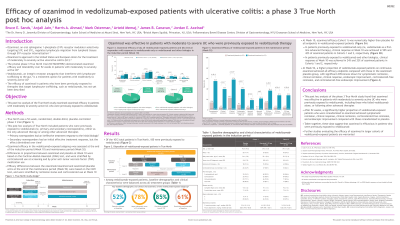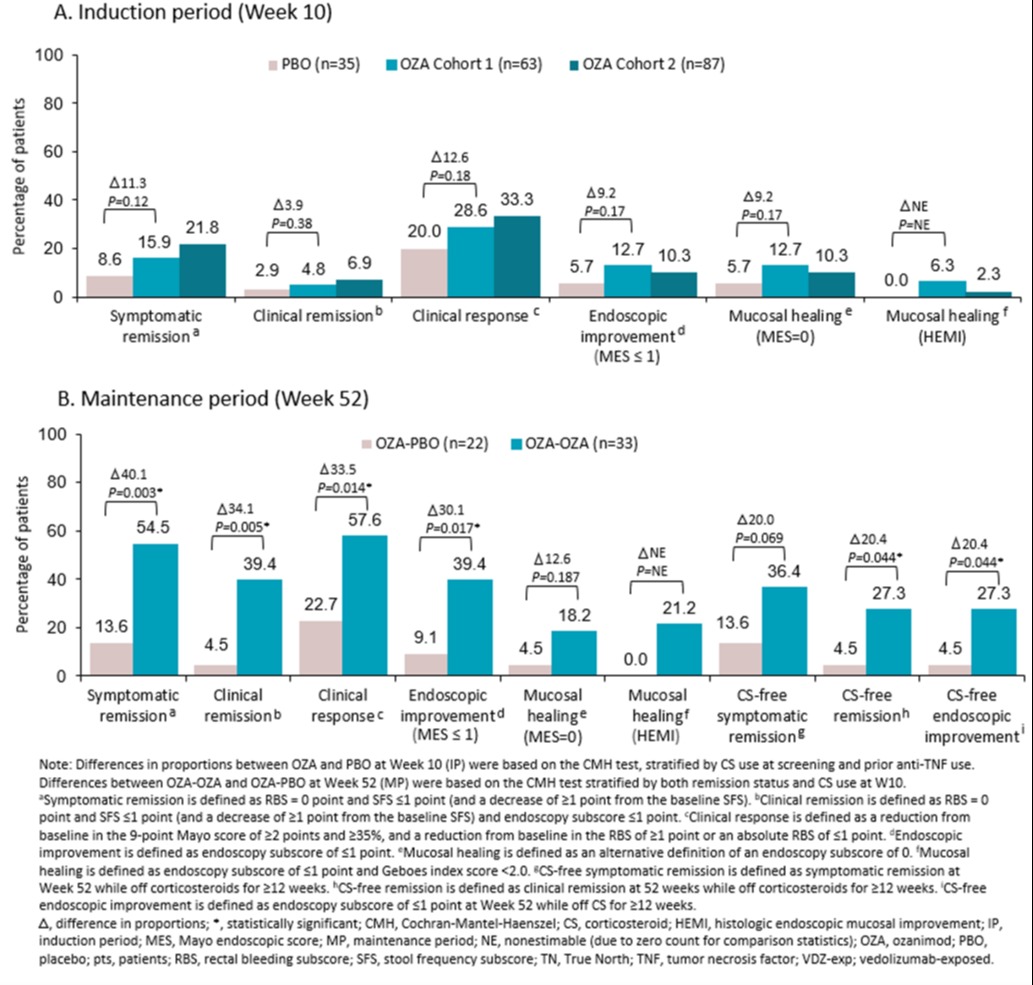Back


Poster Session B - Monday Morning
Category: IBD
B0352 - Efficacy of Ozanimod in Vedolizumab-Exposed Patients With Ulcerative Colitis: A Phase 3 True North Post Hoc Analysis
Monday, October 24, 2022
10:00 AM – 12:00 PM ET
Location: Crown Ballroom

Has Audio

Bruce E. Sands, MD, MS, FACG
Icahn School of Medicine at Mount Sinai
New York, NY
Presenting Author(s)
Bruce E. Sands, MD, MS, FACG1, Anjali Jain, PhD2, Harris A. Ahmad, MD2, Mark Osterman, MD, PhD2, Arteid Memaj, MBA2, James B. Canavan, BA, MB, BCh, BAO2, Jordan Axelrad, MD, MPH3
1Icahn School of Medicine at Mount Sinai, New York, NY; 2Bristol Myers Squibb, Princeton, NJ; 3NYU Grossman School of Medicine, New York, NY
Introduction: Ozanimod (OZA), an oral S1P receptor modulator that prevents lymphocyte migration to inflamed tissues, is approved for the treatment of patients (pts) with moderate to severe ulcerative colitis (UC) in the US and EU. The phase 3 True North (TN) randomized trial showed that OZA was effective and well tolerated in these pts. OZA efficacy in pts who have been exposed to vedolizumab (VDZ-exp), an integrin receptor antagonist that interferes with lymphocyte trafficking to the gut, has not yet been described. This post hoc analysis of TN examined OZA efficacy in VDZ-exp pts.
Methods: In TN, pts were randomized to oral once-daily OZA 0.92 mg (equivalent to OZA HCl 1 mg) or placebo (PBO; Cohort 1) or to open-label OZA (Cohort 2) during the induction period (IP). Pts with a clinical response to OZA at Week (W) 10 were re-randomized to OZA or PBO in the maintenance period (MP). Efficacy at W10 (IP) and W52 (MP) in the VDZ-exp subgroup was calculated. Differences in proportions between OZA and PBO at W10 were based on the Cochran-Mantel-Haenszel (CMH) test, stratified by corticosteroid (CS) use at screening and prior anti-TNF use. Differences between OZA-OZA and OZA-PBO at W52 were based on the CMH test stratified by both remission status and CS use at W10.
Results: TN included a total of 185 VDZ-exp pts (Cohort 1: PBO, n=35; OZA, n=63; and Cohort 2: OZA, n=87). Baseline (BL) demographics and clinical characteristics were balanced across treatment groups. In the VDZ-exp subgroup, 52% of pts had extensive disease at BL, 85% were previously exposed to anti-TNF, and 61% were receiving CS at BL. At W10, OZA (Cohort 1) was numerically more effective vs PBO for all endpoints in VDZ-exp pts (Fig 1A). Notably, in the subgroup of pts previously exposed to VDZ as a first-line advanced therapy, clinical response at W10 was achieved in 50% (6/12) of OZA pts in Cohort 1 and 42% (5/12) of OZA pts in Cohort 2. At W52, a higher proportion of VDZ-exp pts on continuous OZA achieved all efficacy endpoints vs the OZA-PBO group, with significant differences shown for most endpoints; OZA-OZA vs OZA-PBO differences at W52 were larger than OZA vs PBO differences at W10 (Fig 1B).
Discussion: This post hoc analysis of the phase 3 TN study found that OZA was effective in UC pts who previously failed VDZ, including those who failed VDZ alone or following other advanced therapies. This subgroup analysis was limited by small sample sizes. Future studies evaluating OZA in VDZ-exp pts are warranted.

Disclosures:
Bruce E. Sands, MD, MS, FACG1, Anjali Jain, PhD2, Harris A. Ahmad, MD2, Mark Osterman, MD, PhD2, Arteid Memaj, MBA2, James B. Canavan, BA, MB, BCh, BAO2, Jordan Axelrad, MD, MPH3. B0352 - Efficacy of Ozanimod in Vedolizumab-Exposed Patients With Ulcerative Colitis: A Phase 3 True North Post Hoc Analysis, ACG 2022 Annual Scientific Meeting Abstracts. Charlotte, NC: American College of Gastroenterology.
1Icahn School of Medicine at Mount Sinai, New York, NY; 2Bristol Myers Squibb, Princeton, NJ; 3NYU Grossman School of Medicine, New York, NY
Introduction: Ozanimod (OZA), an oral S1P receptor modulator that prevents lymphocyte migration to inflamed tissues, is approved for the treatment of patients (pts) with moderate to severe ulcerative colitis (UC) in the US and EU. The phase 3 True North (TN) randomized trial showed that OZA was effective and well tolerated in these pts. OZA efficacy in pts who have been exposed to vedolizumab (VDZ-exp), an integrin receptor antagonist that interferes with lymphocyte trafficking to the gut, has not yet been described. This post hoc analysis of TN examined OZA efficacy in VDZ-exp pts.
Methods: In TN, pts were randomized to oral once-daily OZA 0.92 mg (equivalent to OZA HCl 1 mg) or placebo (PBO; Cohort 1) or to open-label OZA (Cohort 2) during the induction period (IP). Pts with a clinical response to OZA at Week (W) 10 were re-randomized to OZA or PBO in the maintenance period (MP). Efficacy at W10 (IP) and W52 (MP) in the VDZ-exp subgroup was calculated. Differences in proportions between OZA and PBO at W10 were based on the Cochran-Mantel-Haenszel (CMH) test, stratified by corticosteroid (CS) use at screening and prior anti-TNF use. Differences between OZA-OZA and OZA-PBO at W52 were based on the CMH test stratified by both remission status and CS use at W10.
Results: TN included a total of 185 VDZ-exp pts (Cohort 1: PBO, n=35; OZA, n=63; and Cohort 2: OZA, n=87). Baseline (BL) demographics and clinical characteristics were balanced across treatment groups. In the VDZ-exp subgroup, 52% of pts had extensive disease at BL, 85% were previously exposed to anti-TNF, and 61% were receiving CS at BL. At W10, OZA (Cohort 1) was numerically more effective vs PBO for all endpoints in VDZ-exp pts (Fig 1A). Notably, in the subgroup of pts previously exposed to VDZ as a first-line advanced therapy, clinical response at W10 was achieved in 50% (6/12) of OZA pts in Cohort 1 and 42% (5/12) of OZA pts in Cohort 2. At W52, a higher proportion of VDZ-exp pts on continuous OZA achieved all efficacy endpoints vs the OZA-PBO group, with significant differences shown for most endpoints; OZA-OZA vs OZA-PBO differences at W52 were larger than OZA vs PBO differences at W10 (Fig 1B).
Discussion: This post hoc analysis of the phase 3 TN study found that OZA was effective in UC pts who previously failed VDZ, including those who failed VDZ alone or following other advanced therapies. This subgroup analysis was limited by small sample sizes. Future studies evaluating OZA in VDZ-exp pts are warranted.

Figure: Figure 1. Ozanimod efficacy at TN IP (Week 10) and MP (Week 52) in VDZ-exp pts
Disclosures:
Bruce Sands: Abivax – Consultant, Speaking. Amgen – Consultant. Arena Pharmaceuticals – Consultant. Artugen Therapeutics – Consultant. AstraZeneca – Consultant. Bacainn Therapeutics – Consultant. Boehringer-Ingelheim – Consultant. Boston Pharmaceuticals – Consultant. Bristol Myers Squibb – Consultant, speaking, research funding. Calibr – Consultant. Celltrion Healthcare – Consultant. ClostraBio – Consultant. Eli Lilly and Company – Consultant. Entera – Consultant. Evommune – Consultant. Galapagos – Consultant. Genentech – Consultant. Gilead Sciences – Consultant. GlaxoSmithKline – Consultant. Gossamer Bio – Consultant. InDex Pharmaceuticals – Consultant. Innovation Therapeutics – Consultant. Inotrem – Consultant. Ironwood Pharmaceuticals – Consultant. Janssen – Consultant, Grant/Research Support, speaking. Kaleido – Consultant. Kallyope – Consultant. Miro Bio – Consultant. Morphic Therapeutics – Consultant. MRM Health – Consultant. Pfizer – Consultant, speaking. Progenity – Consultant. Prometheus Biosciences – Consultant. Protagonist Therapeutics – Consultant. Q32 Bio – Consultant. Surrozen – Consultant. Takeda – Consultant, Speaking. Teva – Consultant. TLL Pharmaceutical – Consultant. USWM Enterprises – Consultant. VielaBio – Consultant.
Anjali Jain: Bristol Myers Squibb – Employee, Stock-publicly held company(excluding mutual/index funds).
Harris A. Ahmad: Bristol Myers Squibb – Employee, Stock-publicly held company(excluding mutual/index funds).
Mark Osterman: Bristol Myers Squibb – Employee, Stock-publicly held company(excluding mutual/index funds).
Arteid Memaj: Bristol Myers Squibb – Employee, Stock-publicly held company(excluding mutual/index funds).
James Canavan: Bristol Myers Squibb – Employee, Stock-publicly held company(excluding mutual/index funds).
Jordan Axelrad: AbbVie – Consultant. BioFire Diagnostics – Consultant, Grant/Research Support. BMS – Consultant. Janssen – Consultant. Pfizer – Consultant.
Bruce E. Sands, MD, MS, FACG1, Anjali Jain, PhD2, Harris A. Ahmad, MD2, Mark Osterman, MD, PhD2, Arteid Memaj, MBA2, James B. Canavan, BA, MB, BCh, BAO2, Jordan Axelrad, MD, MPH3. B0352 - Efficacy of Ozanimod in Vedolizumab-Exposed Patients With Ulcerative Colitis: A Phase 3 True North Post Hoc Analysis, ACG 2022 Annual Scientific Meeting Abstracts. Charlotte, NC: American College of Gastroenterology.
